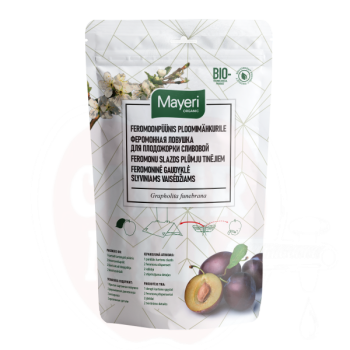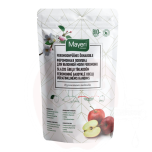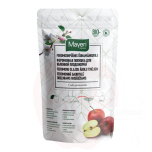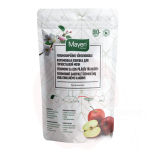Pheromone trap for plum damager
![]() Professionals recommend - producers prefer!
Professionals recommend - producers prefer!
EAN: 4740060005374
Brand: Mayer
Unit: tk
Stock qty: 18
Leveranstid inom Estland för lagervaror ca 3-5 arbetsdagar. OBS! På grund av den snabba prisökningen kan priser för icke-lagervaror ändras utan föregående meddelande! Standardpriser med 22% moms.
179,00 €/Kg
Plum Moth Pheromone Trap - Effective Solution for Pest Control
Package contents:
- 1 cardboard trap
- 2 pheromone capsules
- 2 sticky bases
- 2 fastening elements
Plum Moth Characteristics
Plum moth (Grapholita funebrana) is a small butterfly whose:
- Wingspan: 14-15 mm
- Forewings: dark brown
- Hindwings: metallic shiny brownish-grey
- Light border on wing edges
Pest Life Cycle
Moths fly at dusk, during warm and calm weather after plum tree flowering for 1-2 months. Females lay eggs on young fruits, larvae hatch after 7-10 days. Caterpillars are 12-15 mm long, with pinkish-red bodies and brown heads.
Trap Installation
- Fold up the ends of the trap base
- Place the sticky base adhesive side up
- Position the pheromone capsule in the center of the sticky base
- Attach the trap to a branch using fastening elements
- Install the trap 2-3 m high on the south or west side of the tree
Trap Maintenance and Usage
Check the trap weekly. Replace the sticky base when it becomes dusty or covered with debris. The pheromone capsule needs replacement every 3-4 weeks. For effective control, install one trap per mature tree.
Safety Information
The adhesive is strongly sticky. Use white spirit or cooking oil to clean hands. The trap body can be reused for the same insect species next season.
Usage Effectiveness
Noticeable pest reduction is achieved after 2-3 years of consistent use. It is recommended to continue using traps to maintain pest control.
Keywords: pheromone trap, plum moth, fruit pests, plum pest, pheromone lure, pest control, plant protection, insect trap
| Weight (kg) | 0.050000 |
| High (m) | 0.03 |
| Width (m) | 0.17 |
| Length (m) | 0.27 |
Pea moth pheromone trap is an ecological solution to protect peas from pests. In small gardens, 2-3 traps per pea bed are sufficient. In larger fields, place traps 20 meters apart around the perimeter and several in the center.
Trap Features and Usage
The pheromone trap consists of a plastic housing, sticky base, and pheromone capsules. The device attracts pea moth butterflies that get stuck on the sticky base. With the trap you can detect pest presence in the garden, assess pea moth population, and reduce pest population.
Installation and Maintenance
To install the trap: Bend up the ends of the trap's bottom surface. Place the sticky base with adhesive side up. Place the pheromone capsule in the center of the sticky base. Attach the trap to a branch using included parts.
Package Contents
Package includes: 1 plastic trap, 2 pheromone capsules, 2 adhesive sticky bases, 2 attachment parts.
Pea Moth Description and Life Cycle
Pea moth butterflies have a 12-16 mm wingspan, are gray or brown with yellow side markings. Caterpillars are 6 mm long, white or yellow with dark heads. Pests are active from July to August when they feed on pea pods.
Note! To remove adhesive from hands, use white spirit or cooking oil. Store spare capsules in a cool place in sealed packaging.
Pea moth pheromone trap is an ecological solution to protect peas from pests. In small gardens, 2-3 traps per pea bed are sufficient. In larger fields, place traps 20 meters apart around the perimeter and several in the center.
Trap Features and Usage
The pheromone trap consists of a plastic housing, sticky base, and pheromone capsules. The device attracts pea moth butterflies that get stuck on the sticky base. With the trap you can detect pest presence in the garden, assess pea moth population, and reduce pest population.
Installation and Maintenance
To install the trap: Bend up the ends of the trap's bottom surface. Place the sticky base with adhesive side up. Place the pheromone capsule in the center of the sticky base. Attach the trap to a branch using included parts.
Package Contents
Package includes: 1 plastic trap, 2 pheromone capsules, 2 adhesive sticky bases, 2 attachment parts.
Pea Moth Description and Life Cycle
Pea moth butterflies have a 12-16 mm wingspan, are gray or brown with yellow side markings. Caterpillars are 6 mm long, white or yellow with dark heads. Pests are active from July to August when they feed on pea pods.
Note! To remove adhesive from hands, use white spirit or cooking oil. Store spare capsules in a cool place in sealed packaging.
.png)








